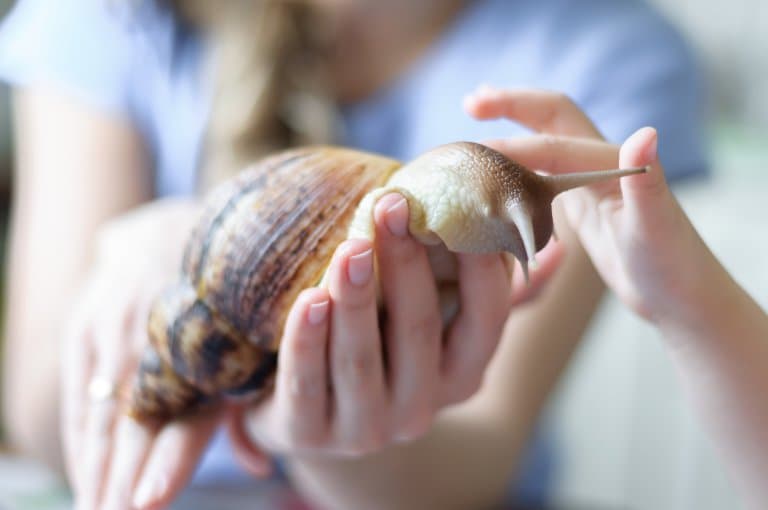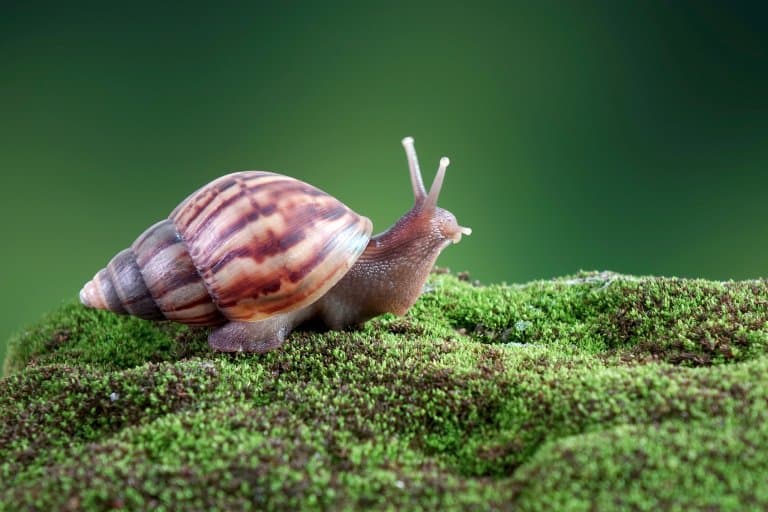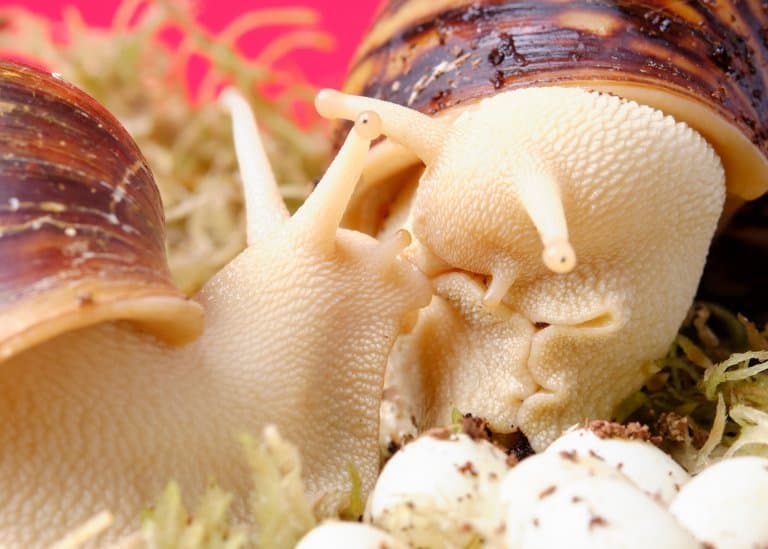Giant African Snail Profile
The Giant African Snail, or Lissachatina Fulica, is a very large mollusc that originates from areas of East Africa, including Kenya, Somalia and Mozambique.
They thrive in hot and humid climates, although they are now known to adapt well to temperate climates, and traditionally inhabit areas of vegetation, such as the edges of forests, the banks of rivers and swamps, or plantations and agricultural crops.
They are nocturnal creatures, as the sun can cause damage to their bodies, and are therefore active at night for travelling, feeding and mating. During the day they will remain in their shells, or burrow underground.

Giant African Snail Facts Overview
| Habitat: | Outskirts of forest, or the edges of rivers, streams and other wetlands, but have adapted to other environments including urban areas |
| Location: | Native to Eastern Africa including Kenya, Somalia and Mozambique. However, due in part to trade as pets and accidentally disbursement, they are now found on every continent except Antarctica |
| Lifespan: | Between 5-7 years usually, but can live up to 10 years in optimal conditions |
| Size: | Can reach up to almost 8 inches in length and between 2.5-4 inches in height |
| Weight: | Adults usually weigh around 32g |
| Color: | Ranging from light to dark brown shell colour, sometimes with reddish streaks or yellow vertical stripes. |
| Diet: | Leaves, flowers, vines, fruits, seeds, bark and moss |
| Predators: | Caterpillars, beetles, other snails and many vertebrates |
| No. of Species: | 1 (3 subspecies) |
| Conservation Status: | Not endangered |
The Giant African Snail has a body length of up to 8 inches, and can reach between 2 and 4 inches high. When fully grown, they are around the size of an adult human fist. Their large shell covers at least half of their body length.
Ranging from a light tan to a dark brown, the shells consist of between 7 and 9 full whorls, with the body whorl being by far the largest, although it has a relatively narrow opening. The shells may also have reddish tints, or yellow streaks.
Giant African Snails are omnivores, eating a diet consisting mostly of plants and vegetation. They have an exceptionally wide diet – eating up to 500 types of plant. They will happily feed on leaves, stems, fruits, seeds, bark and mulch, as well as possibly other smaller snails, sand, stones, plaster, and stucco.
Their taste for crops such as peanuts, cucumbers, peas, beans and melons, has caused havoc for many a farmer, and the Lissachatina Fulica is considered a serious agricultural pest.
Although native to East Africa, the Lissachatina Fulica is now found in many diverse and widespread places across the globe, including parts of Asia, the Americas, Europe and the Pacific. The creature has spread across the world in part through travelling on imported cargo, but also due to demand for import as pets, educational aids, or for human and pet food.
Their rapid rate of reproduction, and their ability to adapt to different environments, withstand temperature extremes, and feed on such a wide variety of food sources, means that they are an extremely invasive species and can cause huge problems when in the wild.
A campaign in Florida in the 1960s cost over a million dollars and almost ten years to eradicate the species. They are therefore considered a serious risk to agriculture, health, and infrastructure in many places.
Interesting Giant African Snail Facts
1. They are one of the largest land snails in the world
While there’s some debate over the largest, certainly the giant African snail is one of the largest in the world, measuring up to 8 inches (20cms) in length!
2. The common name of ‘Giant African Snail’ is actually a name given to three species of giant land snail
These are the Lissachatina Fulica (Giant African Snail), the Achatina Achatina (Ghana Tiger Snail), and the Archachatina Marginata (Margies Snail) 1
3. Giant African Snails require calcium to keep their shells strong
They will feed on many different types of plants to try to accrue the amount of calcium needed to keep their shell in good condition.
However, if the snail fails to get enough calcium from plants alone, it will feel on sand, stones, or even animal bones in order to reach the required amount.

4. Giant African Snails are illegal in all parts of the United States
This is because the creature is regarded to be one of the most invasive species in the world and poses a significant threat to agriculture when loose in the wild. This snail is listed as one of the top 100 invasive species in the world according to the IUCN.
They first entered the United States in 1966 when a boy smuggled three of them into Miami as pets.
His grandmother later released them into her garden. Within the next seven years the population had grown to a massive 18,000 and was extremely difficult for the local government to control and eradicate. 2
5. The Giant African Snail prefers mating to self-fertilization
Although the Giant African Snail is a hermaphrodite, meaning that they have both male and female reproductive organs, they do not seem to self-fertilize.
Instead, they will usually mate with one another. During the mating process, each snail will produce sperm and fertilize the eggs of the other. 3

6. The Giant African Snail can lay up to 500 eggs
Around 8-20 days after mating, the snail will lay between 100 and 500 eggs in the ground, usually in a nest or underneath rocks or plant matter.
The eggs hatch after around 2 weeks and are left to fend for themselves immediately, with no care from the parent snail. However, the hatch success rate is still up at around 90%, so the numbers of this pest can rise very rapidly under the right conditions.
Each snail will generate around 5 clutches of eggs per year. 4
7. The Giant African Snail will estivate in drought conditions and hibernate in cold conditions
The creatures have the capacity to withstand hot, drought-like conditions by retreating into a state of dormancy within their shells. Their bodies can produce a layer of mucus to help keep the snail moist until conditions become more favourable.
During the cold months, they will again retreat into their shells and limit all activity such as moving or eating to conserve energy. They do this by slowing down their metabolism. They can hibernate for up to 3 months.
8. They are an antisocial creature
These snails are not at all a social species and do not communicate with one another, including from parent to offspring. They will usually live most of their life alone, with the exception of mating rituals.
9. Giant African Snails are a food source
Humans in many countries will eat the Giant African Snail, and they are also sold as food for pets such as turtles, large lizards and other small animals.
10. They can move up the 50 metres overnight
However, they will generally not travel more that 250 metres over the course of a year.
11. They are extremely resilient
This is why many attempts to eradicate the species from certain places have proved to be very costly and difficult. 5

12. Giant African Snails pose a threat to humans
This is due to the multiple parasites that they carry, one of which has been known to cause meningitis in humans.
The snails can also harm property by causing damage to plaster and stucco, as well as the significant damage they can do to crops and agriculture. 6
Giant African Snail Fact-File Summary
Scientific Classification
| Kingdom: | Animalia |
| Phylum: | Mollusca |
| Class: | Gastropoda |
| Order: | Stylommotophora |
| Family: | Achatinidae |
| Genus: | Lissachatina |
| Species Name: |
Lissachatina Fulica |
Fact Sources & References
- Shannon Palus (2014), “People Really Need to Stop Bringing Giant African Land Snails Into the US”, Smithsonian Magazine.
- “Giant African Land Snail”, New York Invasive Species (IS) Information.
- “Giant African Land Snails”, DNR.
- “Giant African Snail”, USDA.
- KER THAN (2013), “Giant Snails Invading Florida, “Major Threat” to Crops”, National Geographic.
- (2015), “Giant African snail”, Department of Primary Industies.
